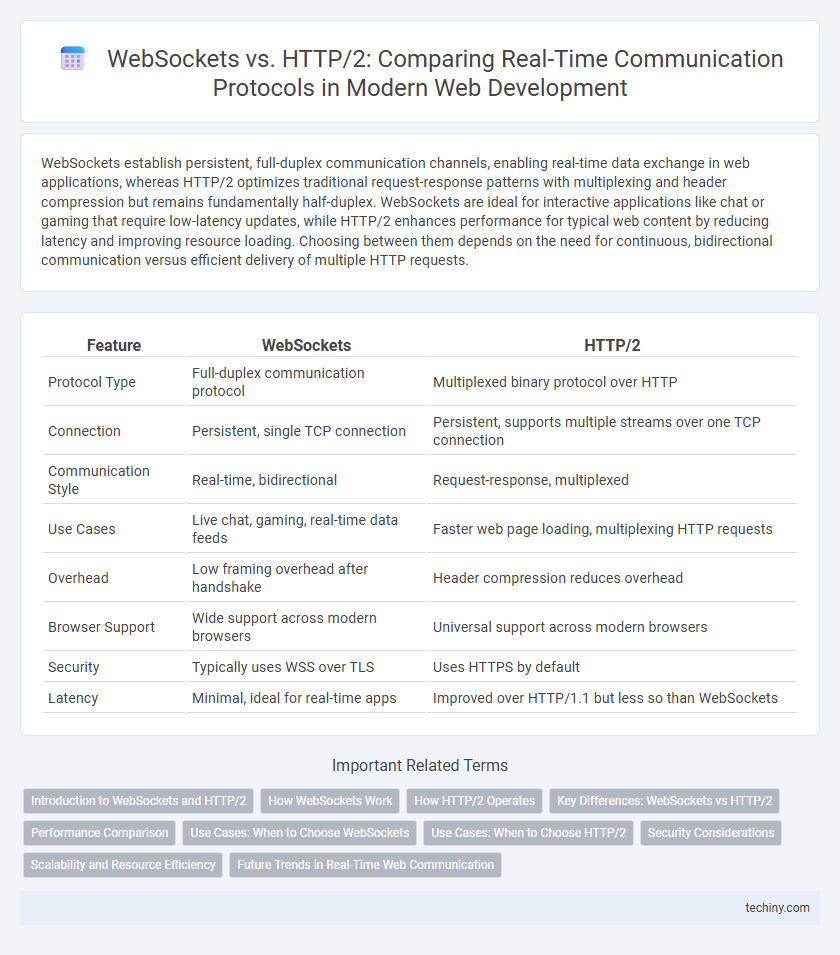WebSockets establish persistent, full-duplex communication channels, enabling real-time data exchange in web applications, whereas HTTP/2 optimizes traditional request-response patterns with multiplexing and header compression but remains fundamentally half-duplex. WebSockets are ideal for interactive applications like chat or gaming that require low-latency updates, while HTTP/2 enhances performance for typical web content by reducing latency and improving resource loading. Choosing between them depends on the need for continuous, bidirectional communication versus efficient delivery of multiple HTTP requests.
Table of Comparison
| Feature | WebSockets | HTTP/2 |
|---|---|---|
| Protocol Type | Full-duplex communication protocol | Multiplexed binary protocol over HTTP |
| Connection | Persistent, single TCP connection | Persistent, supports multiple streams over one TCP connection |
| Communication Style | Real-time, bidirectional | Request-response, multiplexed |
| Use Cases | Live chat, gaming, real-time data feeds | Faster web page loading, multiplexing HTTP requests |
| Overhead | Low framing overhead after handshake | Header compression reduces overhead |
| Browser Support | Wide support across modern browsers | Universal support across modern browsers |
| Security | Typically uses WSS over TLS | Uses HTTPS by default |
| Latency | Minimal, ideal for real-time apps | Improved over HTTP/1.1 but less so than WebSockets |
Introduction to WebSockets and HTTP/2
WebSockets provide a full-duplex communication channel over a single, long-lived TCP connection, enabling real-time data exchange between client and server with low latency. HTTP/2 enhances traditional HTTP by multiplexing multiple streams over a single connection, improving performance and reducing latency through header compression and server push capabilities. Both protocols optimize web communication, but WebSockets excel in bidirectional, event-driven scenarios, while HTTP/2 focuses on efficient request-response interactions.
How WebSockets Work
WebSockets establish a full-duplex communication channel over a single TCP connection, enabling real-time data exchange between client and server without the overhead of repeated HTTP requests. The WebSocket protocol begins with an HTTP handshake to upgrade the connection, after which it switches to a persistent, bidirectional communication model that supports low-latency messaging. This continuous connection model contrasts with HTTP/2's multiplexed streams over a single connection, offering more efficient real-time interactions for applications like chat systems and live updates.
How HTTP/2 Operates
HTTP/2 operates by establishing a single, multiplexed connection over TCP that allows multiple concurrent streams between client and server, significantly reducing latency and enabling efficient resource loading. Unlike traditional HTTP/1.1, it uses header compression via HPACK to minimize overhead and prioritizes stream dependencies for optimized data delivery. This protocol enhances performance with server push capabilities, allowing servers to send resources proactively before the client requests them.
Key Differences: WebSockets vs HTTP/2
WebSockets enable full-duplex communication with low latency, maintaining a single, persistent connection between client and server, ideal for real-time applications like chat or gaming. HTTP/2 focuses on multiplexing multiple request-response pairs over a single connection, improving page load speed and resource efficiency without enabling real-time bidirectional messaging. WebSockets utilize a distinct protocol after an initial HTTP handshake, while HTTP/2 remains an enhanced version of HTTP, optimizing standard request/response patterns.
Performance Comparison
WebSockets offer persistent, full-duplex communication channels that significantly reduce latency and overhead compared to HTTP/2's request-response model. HTTP/2 improves performance through multiplexing and header compression but still incurs higher latency due to repeated handshakes and stateless connections. For real-time applications requiring low-latency data exchange, WebSockets outperform HTTP/2 by maintaining continuous open connections.
Use Cases: When to Choose WebSockets
WebSockets are ideal for real-time applications requiring persistent, low-latency bi-directional communication, such as online gaming, live chat, and financial tickers. Unlike HTTP/2, which excels in multiplexed request-response handling, WebSockets maintain a continuous open connection, enabling instant data exchange without repeated handshakes. Choosing WebSockets over HTTP/2 is essential when immediate and frequent data updates between the client and server are critical for user experience.
Use Cases: When to Choose HTTP/2
HTTP/2 is ideal for websites requiring multiplexed requests and enhanced performance through header compression, especially in content-heavy environments like news sites or e-commerce platforms. It excels in scenarios demanding low-latency page loads with multiple parallel resources such as images, stylesheets, and scripts. HTTP/2 is preferred when maintaining compatibility with existing HTTP infrastructure and when real-time bi-directional communication is not a primary requirement.
Security Considerations
WebSockets and HTTP/2 both utilize TLS for encryption, ensuring secure data transmission through HTTPS. WebSockets can maintain persistent, full-duplex communication channels, which require robust authentication and validation to prevent common vulnerabilities like cross-site WebSocket hijacking (CSWSH). HTTP/2 offers built-in security features such as header compression and multiplexing, reducing exposure to certain attack vectors like man-in-the-middle (MITM) attacks and improving overall connection integrity.
Scalability and Resource Efficiency
WebSockets provide superior scalability and resource efficiency compared to HTTP/2 by enabling persistent, full-duplex communication channels that reduce overhead from repeated handshakes and header exchanges. Unlike HTTP/2, which establishes new streams for each request, WebSockets maintain a single connection for continuous data flow, lowering CPU and memory usage on servers handling numerous concurrent clients. This persistent connection model allows real-time applications to scale more effectively, conserving bandwidth and minimizing latency.
Future Trends in Real-Time Web Communication
WebSockets enable persistent, full-duplex communication, making them ideal for real-time applications like gaming and chat, while HTTP/2 enhances performance with multiplexing and header compression but remains fundamentally request-response based. Emerging trends indicate HTTP/3 and WebTransport protocols will further evolve real-time web communication by combining UDP's speed with reliability improvements, potentially surpassing traditional WebSockets. Developers should monitor these innovations to optimize latency, scalability, and security in future web applications.
WebSockets vs HTTP/2 Infographic

 techiny.com
techiny.com